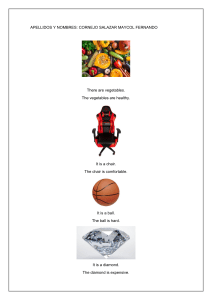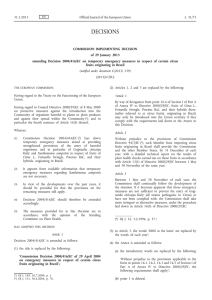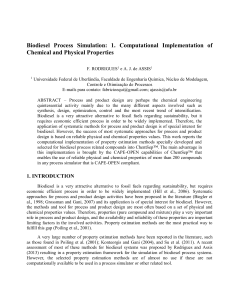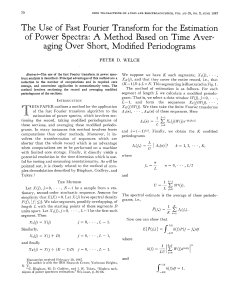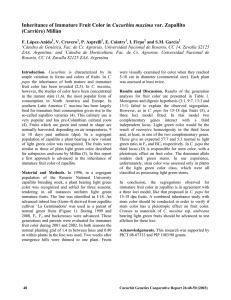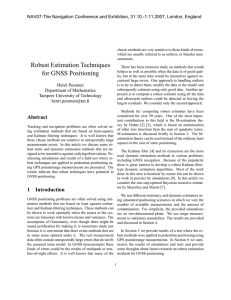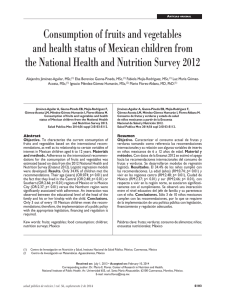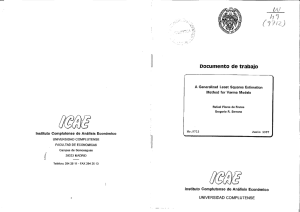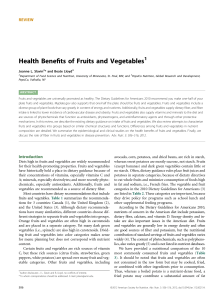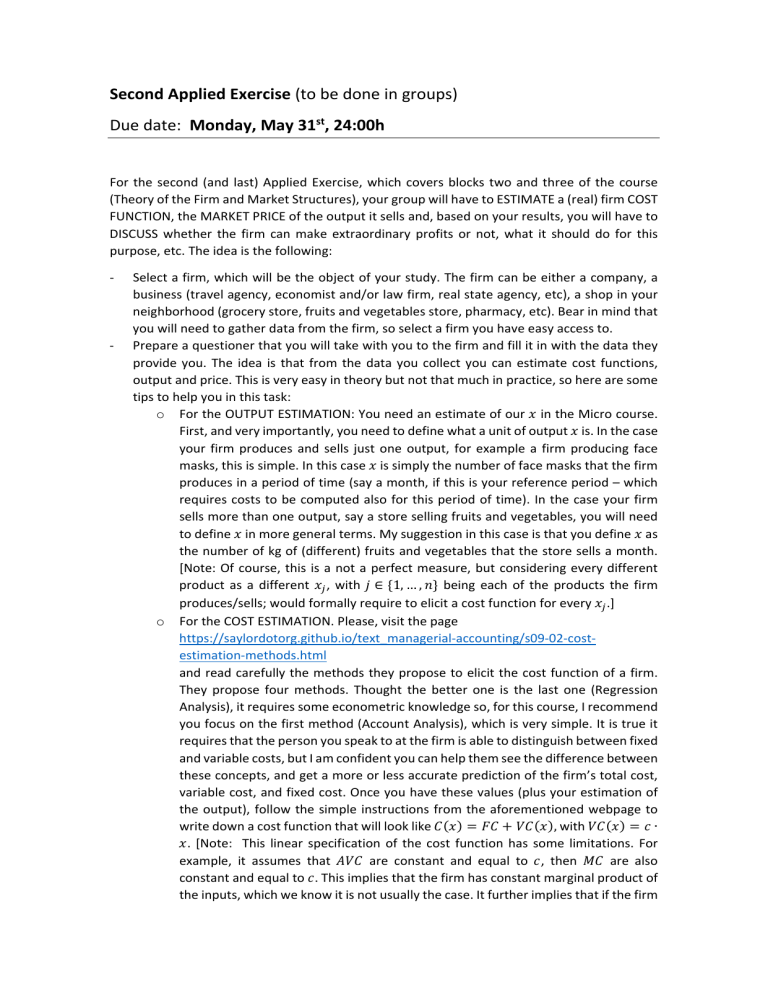
Second Applied Exercise (to be done in groups) Due date: Monday, May 31st, 24:00h For the second (and last) Applied Exercise, which covers blocks two and three of the course (Theory of the Firm and Market Structures), your group will have to ESTIMATE a (real) firm COST FUNCTION, the MARKET PRICE of the output it sells and, based on your results, you will have to DISCUSS whether the firm can make extraordinary profits or not, what it should do for this purpose, etc. The idea is the following: ‐ ‐ Select a firm, which will be the object of your study. The firm can be either a company, a business (travel agency, economist and/or law firm, real state agency, etc), a shop in your neighborhood (grocery store, fruits and vegetables store, pharmacy, etc). Bear in mind that you will need to gather data from the firm, so select a firm you have easy access to. Prepare a questioner that you will take with you to the firm and fill it in with the data they provide you. The idea is that from the data you collect you can estimate cost functions, output and price. This is very easy in theory but not that much in practice, so here are some tips to help you in this task: o For the OUTPUT ESTIMATION: You need an estimate of our 𝑥 in the Micro course. First, and very importantly, you need to define what a unit of output 𝑥 is. In the case your firm produces and sells just one output, for example a firm producing face masks, this is simple. In this case 𝑥 is simply the number of face masks that the firm produces in a period of time (say a month, if this is your reference period – which requires costs to be computed also for this period of time). In the case your firm sells more than one output, say a store selling fruits and vegetables, you will need to define 𝑥 in more general terms. My suggestion in this case is that you define 𝑥 as the number of kg of (different) fruits and vegetables that the store sells a month. [Note: Of course, this is a not a perfect measure, but considering every different product as a different 𝑥 , with 𝑗 ∈ 1, … , 𝑛 being each of the products the firm produces/sells; would formally require to elicit a cost function for every 𝑥 .] o For the COST ESTIMATION. Please, visit the page https://saylordotorg.github.io/text_managerial‐accounting/s09‐02‐cost‐ estimation‐methods.html and read carefully the methods they propose to elicit the cost function of a firm. They propose four methods. Thought the better one is the last one (Regression Analysis), it requires some econometric knowledge so, for this course, I recommend you focus on the first method (Account Analysis), which is very simple. It is true it requires that the person you speak to at the firm is able to distinguish between fixed and variable costs, but I am confident you can help them see the difference between these concepts, and get a more or less accurate prediction of the firm’s total cost, variable cost, and fixed cost. Once you have these values (plus your estimation of the output), follow the simple instructions from the aforementioned webpage to write down a cost function that will look like 𝐶 𝑥 𝐹𝐶 𝑉𝐶 𝑥 , with 𝑉𝐶 𝑥 𝑐∙ 𝑥. [Note: This linear specification of the cost function has some limitations. For example, it assumes that 𝐴𝑉𝐶 are constant and equal to 𝑐, then 𝑀𝐶 are also constant and equal to 𝑐. This implies that the firm has constant marginal product of the inputs, which we know it is not usually the case. It further implies that if the firm ‐ ‐ ‐ is price‐taker, the condition 𝑃 𝑀𝐶 𝑥 might not hold. Despite these important limitations, estimating non‐linear cost functions would require on the one hand, more data (for a period of time, not just one observation), and on the other hand, the use of sophisticated econometric methods (for example, non‐parametric analysis). This is out of the scope of this course, so we will be happy with our linear estimation 😉!!). o For the market PRICE ESTIMATION: The market price 𝑝 refers to the price at which the firm sells one unit of output 𝑥. Again, in the case the firm produces face masks this is simple: 𝑝 is the price at which the firm sells one face mask. In the case your firm is a store selling fruits and vegetables, you will need to define 𝑝 in more general terms. My suggestion in this case is that you define 𝑝 as the average price of one kg of the typical consumption bundle sold in the store. At this state, you can calculate 𝑀𝐶 𝑥 , 𝐴𝐶 𝑥 , 𝐴𝑉𝐶 𝑥 and represent them. In a different graph, represent the 𝐶 𝑥 function and obtain the level of output 𝑥 that minimizes this cost function, the so‐called minimum efficient scale. Let us call this value 𝑥 . Obtain the price that corresponds to the minimum efficient scale and compare it with the estimation of the market price. Discuss which one is bigger and the implications you think it might have for the firm (think in terms of profits). Finally, compare the minimum efficient scale output (𝑥 ) with the declared output by the firm. Discuss which one is bigger and the implications you think it might have for the firm (in terms of profits) depending on whether you think the firm operates in a pure competitive market or if it has some market power. Some hints ‐ ‐ If a firm is price‐taker and has linear cost function, the first order condition 𝑃 𝑀𝐶 𝑥 might not hold. In this case, 𝑥 might be the candidate for the output level that maximizes the firm’s profits. In contrast to this, if the firm has market power it might not be interested in producing too much. Think about the role of capacity constraints, i.e., whether the firm is able to produce/sell any output level given its current plant size (level of installed capital) or if, in contrast, producing more than a certain level of output would require a higher plant size, hence a different cost function (e.g. higher fixed costs). Recommended length: 3 or 4 pages. Maximum length: 5 pages.


